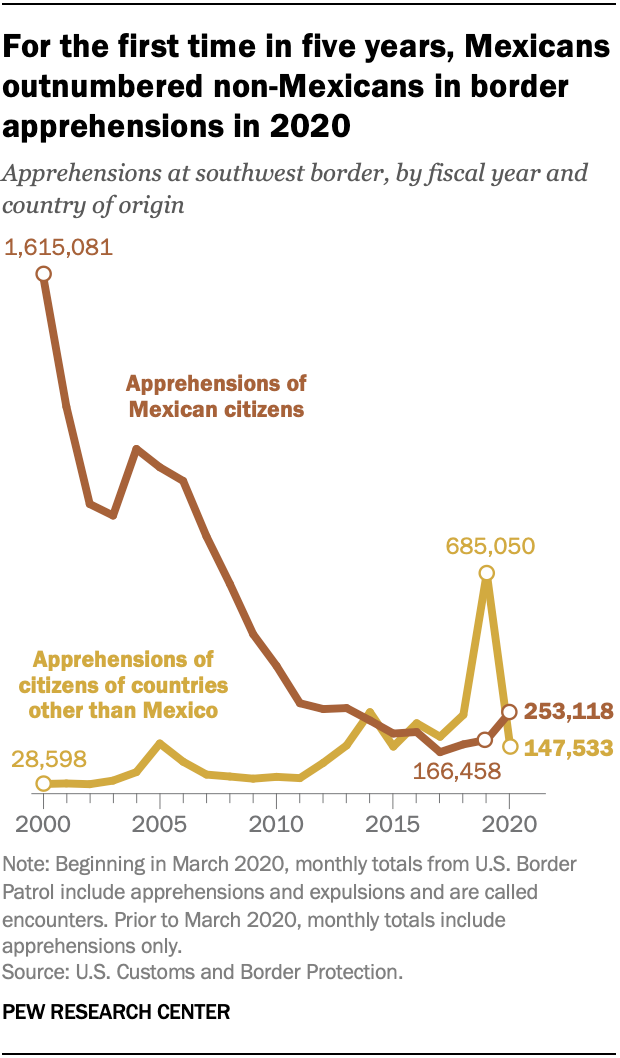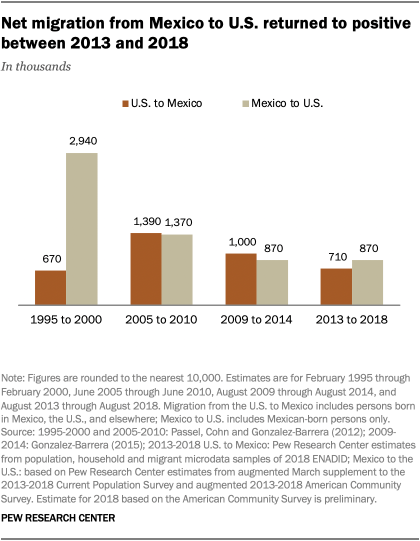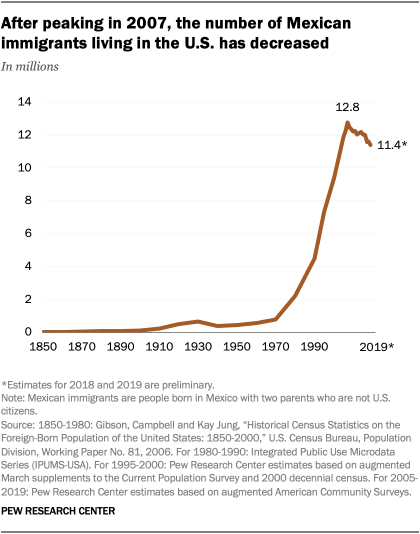More Mexican migrants came to the United States than left the U.S. for Mexico between 2013 and 2018 – a reversal of the trend in much of the prior decade, according to a new Pew Research Center analysis of the most recently available data capturing migration flows from both countries.
An estimated 870,000 Mexican migrants came to the U.S. between 2013 and 2018, while an estimated 710,000 left the U.S. for Mexico during that period. That translates to net migration of about 160,000 people from Mexico to the U.S., according to government data from both countries.
In the period from 2009 to 2014, by contrast, about a million people left the U.S. for Mexico while 870,000 Mexicans made the reverse trip, for net migration of about 130,000 people from the U.S. to Mexico. A similar trend from 2005 to 2010 resulted in effectively zero net migration between the two countries. (Due to the way the Mexican government sources report data, this analysis uses several overlapping time periods: 2005-2010, for example, and 2009-2014. In addition, migration from Mexico in this analysis includes only those who were born there, while migration to Mexico includes those born in Mexico, the U.S., and elsewhere.)
Measuring migration flows between Mexico and the U.S. is challenging because there are no official counts of how many Mexican immigrants enter and leave the U.S. each year. This analysis uses the best available government data from both countries to estimate the size of these flows. For this analysis, migration from the U.S. to Mexico includes persons born in Mexico, the U.S., and elsewhere, while migration from Mexico to the U.S. includes Mexican-born persons only.
To estimate how many people have left the U.S. for Mexico, this analysis uses data from the 2018 and 2014 Mexican National Survey of Demographic Dynamics (or ENADID) and the 2020, 2010 and 2000 Mexican decennial censuses. Respondents are asked where they had been living five years prior to the date when the survey or census was taken. The answers to this question provide an estimate of the number of people who moved from the U.S. to Mexico during the five years prior to the survey date. A separate question focuses on those who have recently left Mexico. It asks whether anyone from the household had left for another country during the previous five years; if so, additional questions are asked about whether and when that person or people came back and their reasons for returning to Mexico.
To estimate how many Mexicans left Mexico for the U.S., this analysis uses the U.S. Census Bureau’s American Community Survey (2005-2019) and the Current Population Survey (1990-2019), which ask immigrants living in the U.S. about their country of birth and the year of their arrival in the U.S. Both sources are adjusted for undercount.
Other sources of information include detailed tables released by the U.S. Department of Homeland Security’s Office of Immigration Statistics, the U.S. Department of State, and U.S. Customs and Border Protection.
The main change in net flow between the two countries in the most recent period comes from the decreased return flow from the U.S. to Mexico – 1.0 million from 2009 to 2014 down to 710,000 from 2013 to 2018 – rather than an increase in the number of Mexican immigrants coming to the U.S. The number of Mexican immigrants going from Mexico to the U.S. stood unchanged at 870,000 for both 2009 to 2014 and 2013 to 2018.
There are several potential reasons for the changing patterns of migration flows between the two nations. In the U.S., job losses during the Great Recession of 2007-2009 in industries in which immigrants tend to be heavily represented may have pushed a large number of Mexicans to migrate back to Mexico, which in the aftermath of the recession also made the U.S. less attractive to potential Mexican migrants. In addition, stricter enforcement of U.S. immigration laws both at the southwest border and within the interior of the U.S. may have contributed to the reduction in Mexican immigrants coming to the U.S. in the years leading up to 2013.
Some changing patterns in Mexico could also be behind the reduction in the number of immigrants coming to the U.S. since the Great Recession. First, growth in the working-age population of Mexicans has slowed due to a decades-long decline in the average number of births among women in Mexico. Lower fertility rates also mean smaller family sizes, which reduces the need for migration as a means of family financial support. Coupled with this, the Mexican economy over the past two decades has been more stable than in the 1980s and 1990s, when the country was hit with a number of profound economic crises.
While net migration from Mexico to the U.S. turned positive from 2013 to 2018 for the first time in more than a decade, it remained far below the levels seen in earlier decades when migration from Mexico to the U.S. was at its peak. In the five-year period between 1995 and 2000, for example, nearly 3 million immigrants came to the U.S. from Mexico, while only around 670,000 made the reverse trip, for net migration of nearly 2.3 million people from Mexico to the U.S.
Mexico is the largest country of birth among the estimated 47 million immigrants living in the U.S., according to preliminary estimates based on the 2019 American Community Survey. About 24% of all U.S. immigrants were born in Mexico.
Total number of Mexican immigrants living in the U.S. declined between 2007 and 2019
After peaking at 12.8 million in 2007, the number of Mexican immigrants living in the U.S. has declined in recent years. Preliminary estimates show that in 2019, the overall population of Mexican immigrants in the U.S. was 11.4 million, or about 1.4 million below the number at the onset of the Great Recession.
The decline in Mexican immigrants in the U.S. has been due mostly to a decrease of about 2 million unauthorized Mexican immigrants, from a peak of 6.9 million in 2007 to an estimated 4.9 million in 2017, according to Pew Research Center’s latest estimate of the unauthorized population in the U.S.
Mexican immigrants have been at the center of one of the largest mass migrations in modern history. Between 1965 and 2015, more than 16 million Mexican immigrants migrated to the U.S. – more than from any other country.
In 1970, fewer than 1 million Mexican immigrants lived in the U.S. By 2000, that number had grown to 9.4 million, and by 2007 it peaked at 12.8 million.
The amount of Mexican migration during coronavirus outbreak remains unclear
At the start of the coronavirus pandemic, the U.S. and Mexican governments shut down their land borders to all non-essential travel, and the U.S. has yet to reopen them after more than a year. Travel in most of the world was disrupted during the pandemic and migration flows seemed to dwindle. However, it is still unclear how the coronavirus pandemic has affected migration flows from Mexico to the U.S. and vice versa. The two main sources for this kind of information, the U.S. Census Bureau’s surveys and the Mexican government’s INEGI data, are not yet available for the period covering the pandemic, while other data sources only offer a partial view. These secondary sources, however, do hint at some of the changes that might be underway since the coronavirus outbreak started.
One of these data points is the number of immigrants who entered the U.S. in fiscal 2020 through permanent legal residency, also known as a “green card.” In fiscal 2020, about 30,500 Mexican immigrants entered the U.S. this way, down 45% from the prior year. The reduction during the fiscal year, which ran from Oct. 1, 2019, to Sept. 30, 2020, was particularly notable in the months after the coronavirus outbreak began: Between April and September 2020, the number of Mexican green card recipients dropped by 90% compared with the same period in the prior year.
Another available data point is the number of Mexican immigrants who entered the U.S. through a temporary work visa, such as the H-2A visa for farmworkers, or the TN or H-1B visas for high-skilled immigrants. In fiscal 2020, Mexican farmworkers obtained about 198,000 temporary permits to come work in the U.S., up 5% from the prior fiscal year – an annual increase far lower than those seen in most years leading up to the pandemic. Meanwhile, the number of high-skilled Mexican workers who obtained a TN or H-1B visa dropped 36% in the same period, from about 24,000 to 15,000.
Another snapshot of Mexican immigration flows relates to unauthorized immigrants, including those who come to the U.S. temporarily on a visa and overstay their permit and those who cross the border without inspection and reside in the U.S. as unauthorized immigrants.
While data on visa overstays during the pandemic is not available, the number of people traveling into the U.S. during the pandemic went down and the number of non-immigrant visas issued in Mexico also declined. In fiscal 2020, the total number of non-immigrant visas processed in Mexico by the U.S. Department of State dropped 35% compared with the prior year, from about 1.5 million in 2019 to about 960,000 in 2020. Most of these temporary visas were processed for tourism, business or for crossing the border and do not include a work authorization.

By contrast, apprehensions of unauthorized Mexican immigrants – a statistic that is often used as a proxy for measuring illegal immigration – increased considerably after the pandemic started in 2020, even as apprehensions of non-Mexicans dropped sharply. In fiscal 2020, the number of encounters or apprehensions of Mexican adults at the U.S.-Mexican border reached levels not seen since 2013. There were 253,118 such encounters, up 52% from 166,458 the year before.
It is important to note that apprehensions at the border were handled differently in fiscal 2020 than in years immediately prior due to an executive order called Title 42, authorized by former President Donald Trump. Under the order, Border Patrol agents did not always conduct a formal apprehension and removal, but instead sent immigrants directly back to Mexico without those steps.
Some analysts say that the new procedures have increased the number of immigrants from Mexico and elsewhere who try to enter the U.S. illegally multiple times. The number of immigrants with a prior encounter with a Border Patrol agent increased considerably in fiscal year 2020, according U.S. Customs and Enforcement data.

